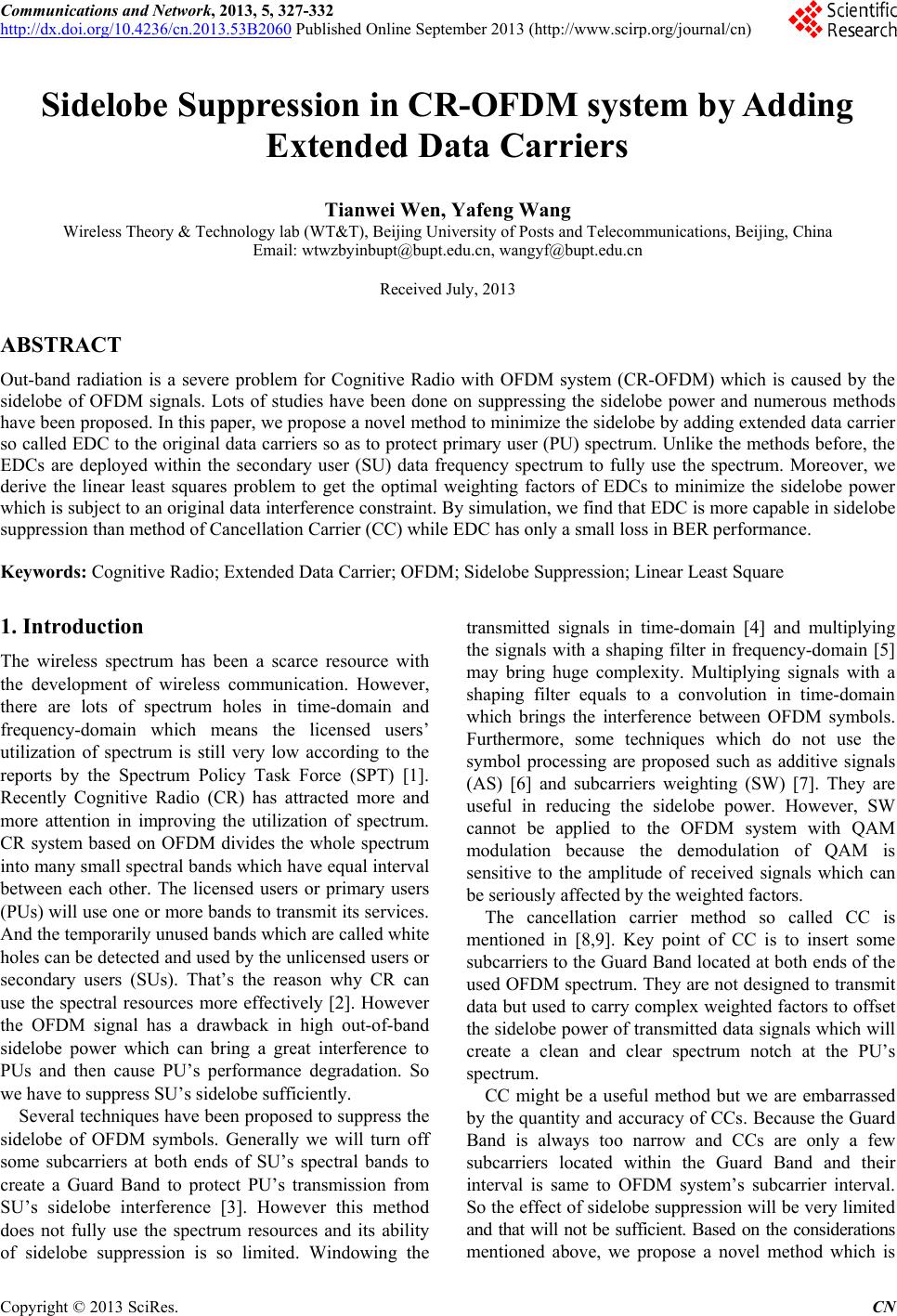
Communications and Network, 2013, 5, 327-332
http://dx.doi.org/10.4236/cn.2013.53B2060 Published Online September 2013 (http://www.scirp.org/journal/cn)
Sidelobe Suppression in CR-OFDM system by Adding
Extended Data Carriers
Tianwei Wen, Yafeng Wang
Wireless Theory & Technology lab (WT&T), Beijing University of Posts and Telecommunications, Beijing, China
Email: wtwzbyinbupt@bupt.edu.cn, wangyf@bupt.edu.cn
Received July, 2013
ABSTRACT
Out-band radiation is a severe problem for Cognitive Radio with OFDM system (CR-OFDM) which is caused by the
sidelobe of OFDM signals. Lots of studies have been done on suppressing the sidelobe power and numerous methods
have been proposed. In this paper, we propose a novel method to minimize the sidelobe by adding extended data carrier
so called EDC to the original data carriers so as to protect primary user (PU) spectrum. Unlik e the methods before, the
EDCs are deployed within the secondary user (SU) data frequency spectrum to fully use the spectrum. Moreover, we
derive the linear least squares problem to get the optimal weighting factors of EDCs to minimize the sidelobe power
which is subject to an original data in terference constraint. By simulation, we find that EDC is more capable in sidelobe
suppression than method of Cancellation Carrier (CC) while EDC has only a small loss in BER performance.
Keywords: Cognitive Radio; Extended Data Carrier; OFDM; Sidelobe Suppression; Linear Least Square
1. Introduction
The wireless spectrum has been a scarce resource with
the development of wireless communication. However,
there are lots of spectrum holes in time-domain and
frequency-domain which means the licensed users’
utilization of spectrum is still very low according to the
reports by the Spectrum Policy Task Force (SPT) [1].
Recently Cognitive Radio (CR) has attracted more and
more attention in improving the utilization of spectrum.
CR system based on OFDM divides the whole spectrum
into many small spectral bands which have equal interval
between each other. The licensed users or primary users
(PUs) will use one or more bands to transmit its services.
And the temporarily unused bands which are called white
holes can be detected and used by the unlicensed users or
secondary users (SUs). That’s the reason why CR can
use the spectral resources more effectively [2]. However
the OFDM signal has a drawback in high out-of-band
sidelobe power which can bring a great interference to
PUs and then cause PU’s performance degradation. So
we have to suppress SU’s sidelobe sufficiently.
Several techniques have been proposed to suppress the
sidelobe of OFDM symbols. Generally we will turn off
some subcarriers at both ends of SU’s spectral bands to
create a Guard Band to protect PU’s transmission from
SU’s sidelobe interference [3]. However this method
does not fully use the spectrum resources and its ability
of sidelobe suppression is so limited. Windowing the
transmitted signals in time-domain [4] and multiplying
the signals with a shaping filter in frequency-domain [5]
may bring huge complexity. Multiplying signals with a
shaping filter equals to a convolution in time-domain
which brings the interference between OFDM symbols.
Furthermore, some techniques which do not use the
symbol processing are proposed such as additive signals
(AS) [6] and subcarriers weighting (SW) [7]. They are
useful in reducing the sidelobe power. However, SW
cannot be applied to the OFDM system with QAM
modulation because the demodulation of QAM is
sensitive to the amplitude of received signals which can
be seriously affected by the weighted factors.
The cancellation carrier method so called CC is
mentioned in [8,9]. Key point of CC is to insert some
subcarriers to the Guard Band located at both ends of the
used OFDM spectrum. They are not designed to transmit
data but used to carry complex weighted factors to offset
the sidelobe power of transmitted data signals which will
create a clean and clear spectrum notch at the PU’s
spectrum.
CC might be a useful method but we are embarrassed
by the quantity and accuracy of CCs. Because the Guard
Band is always too narrow and CCs are only a few
subcarriers located within the Guard Band and their
interval is same to OFDM system’s subcarrier interval.
So the effect of sidelobe suppression will be very limited
and that will not be sufficient. Based on the considerations
mentioned above, we propose a novel method which is
C
opyright © 2013 SciRes. CN